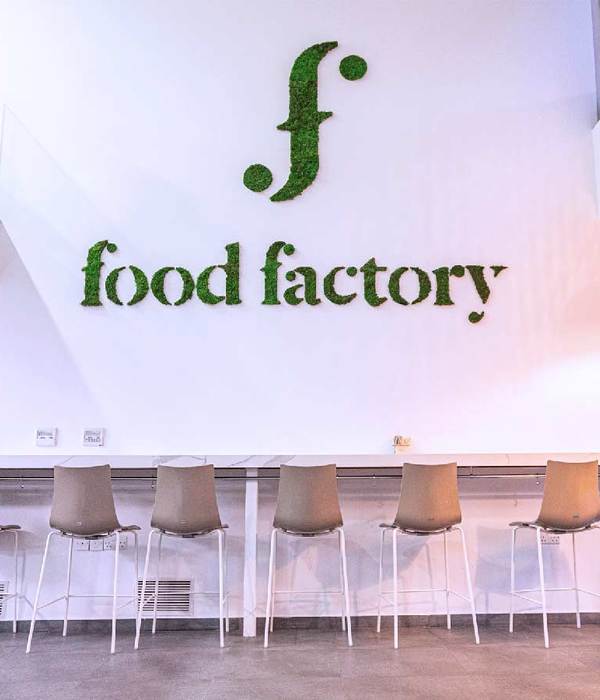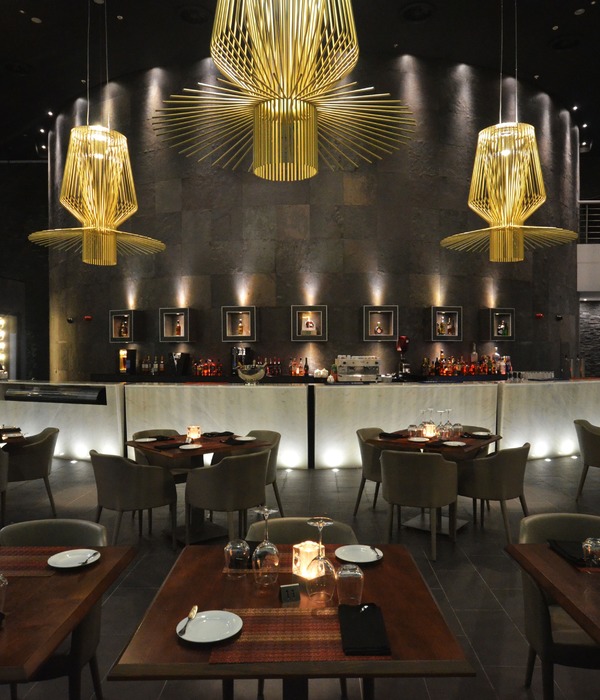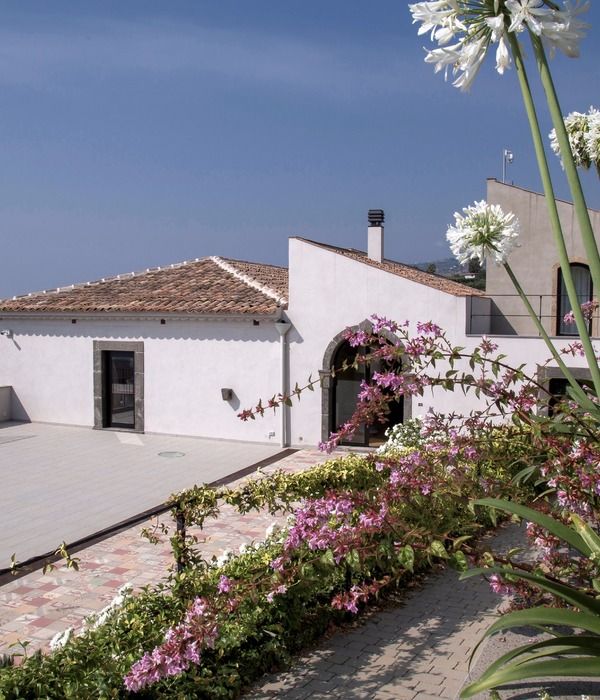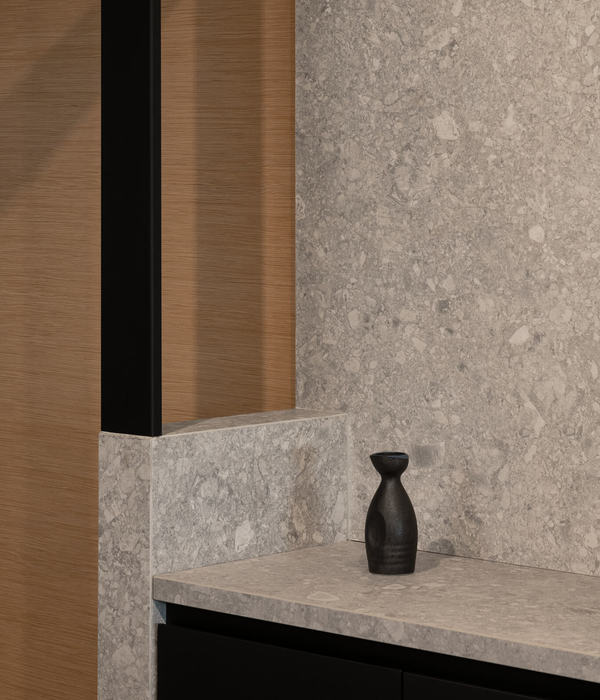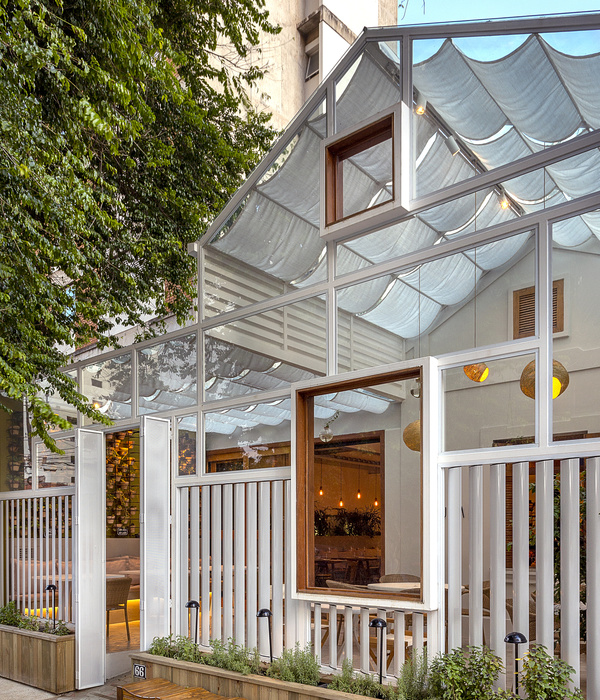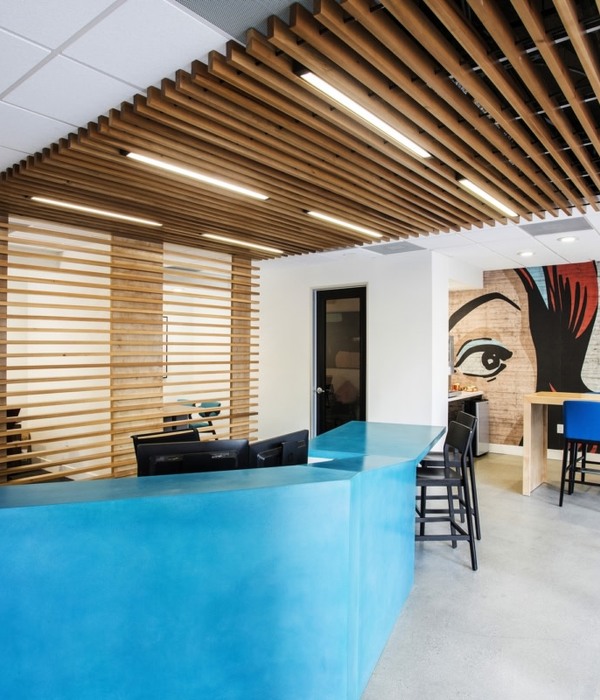武汉有着3500多年的历史,不仅是中国最古老、人口最多的大都市之一,而且是中部经济文化发展的繁荣中心。随着城市的快速变化,其居民的口味也迅速变化,虽然当地食品保持着其几乎传奇的名声,但消费者越来越渴望创新的烹饪体验。
With a history of 3500 years, Wuhan is not only one of the most ancient and populated metropolitan cities in China, but also the thriving heart of Central China’s economic and cultural development. As the city rapidly changes so does the taste of its inhabitants, and while local food retains its almost legendary fame, customers are increasingly eager for innovative culinary experiences.
▼正门,front door of the building
2016年底,武汉一家知名的国际化餐饮集团邀请上海问和答建筑设计咨询有限公司为其设计一间可以提供冷热菜肴、咖啡和烘焙产品的旗舰餐厅。经过近两年的进展,Q&A揭开了萨丁伯格的面纱,这个设计概念把烹饪放在了行为的中心,强调了参与过程中演员和观众之间的互动。
In late 2016, Q&A Architecture Design Research was asked by a leading international food and beverage group in Wuhan to design a flagship restaurant serving both hot and cold dishes, coffee and bakery products. After almost two years of development Q&A unveiled Saltimbocca, a concept where the act of cooking is placed at the very center of the action, highlighting the interaction between actors and spectators involved in the process.
▼把烹饪放在了行为的中心,强调了参与过程中演员和观众之间的互动,the act of cooking is placed at the very center of the action, highlighting the interaction between actors and spectators involved in the process
跨越两层,萨丁伯格有四个不同的厨房,每个厨房都有独特的材料和色彩搭配。从任意一个街道入口进入,顾客可以立即感知到这些不同的个性在空间中的共存,就如同从白色六角形瓷砖的浩瀚大海中显现出来的独特的陆地。
Spreading across two floors, Saltimbocca has four different kitchens, each identified with a unique palette of materials and colors. As visitors access from any of the three street-level entrances, they can instantly perceive the coexistence of these different personalities in the space, as distinct islands emerging from a vast sea of white hexagonal ceramic tiles.
▼每个厨房都有独特的材料和色彩搭配,each kitchen identified with a unique palette of materials and colors
在准备和提供冷菜、前菜的绿色厨房之上,是一个跨层的、宏伟的、灯笼般的烟囱,它作为视觉的中心,并联系一楼的繁忙活动以及楼上更为拘谨的气氛。
Above the Green Kitchen, where cold dishes and starters are prepared and served, the chimney is a grand, lantern-like volume spanning across the two storeys, which serves as the visual centerpiece and connects the hectic activity of the ground floor to the more discreet atmosphere upstairs.
▼跨层的、宏伟的、灯笼般的烟囱作为视觉的中心,a grand, lantern-like volume spanning across the two storeys, which serves as the visual centerpiece
咖啡和烘焙区是由相似的结构和美学形式联系起来的独立室内店面。这两个空间参照了当代咖啡厅的精髓特征,有黑色或白色的瓷砖,深灰色和铬色饰面,铸石台面。当然,还要剥开表面到本质,让产品为自己说话。
The coffee and bakery areas are separate indoor storefronts connected by a similar structure and aesthetics. The two spaces reference the quintessential features of the contemporary coffee shop, with black or white brick tiles, dark grey and chrome finishes, cast stone countertop, yet stripped down to the essence to allow the products to speak for themselves.
▼咖啡和烘焙区是由相似的结构和美学形式联系起来的独立的室内店面,the coffee and bakery areas are separate indoor storefronts connected by a similar structure and aesthetics
在正门的对面,红色厨房的红颜色与白色大理石和铁的冷色形成鲜明对比。在12米长的台面上,就餐者可以在等待菜肴时看到食物炙烤、沸腾和油炸的景象。
Right across the main entrance, the blush colors of the Red Kitchen contrasts with the coldness of the white marble and steel. Over the 12-meter long countertop, diners can behold the spectacle of grilling, boiling and frying as they wait for their dishes.
▼红色厨房的红颜色与白色大理石和铁的冷色形成鲜明对比,the blush colors of the Red Kitchen contrasts with the coldness of the white marble and steel
这个楼梯十分重要,在两层楼之间提供了一个安静的过渡,光通过红色厨房后面玻璃砖的过滤,变成暖光,充满楼梯间。
The monumental staircase provides a quiet transition between the two floors, and is infused with the warm light filtering through the glass block wall behind the Red Kitchen.
▼红色厨房后面玻璃砖的过滤,使楼梯充满了暖光,warm light filtering through the glass block wall behind the Red Kitchen
昏暗低调的二层与明亮的一层不同,二层有四个挑空空间,以允许多角度观察下面的喧嚣。通过栏杆宽的穿孔钢板过滤,厨房区域的明亮色调到达二层逐渐变弱。
Dim and understated, the second floor is detached from its brighter counterpart yet four openings allow multiple perspectives on the hustle and bustle below. The bright tones of the kitchen area reach up in fading gradient as they filter through the wide perforated steel panels of the handrails.
▼二层挑空空间和栏杆宽度的穿孔钢板,openings through the second floor and wide perforated steel panels of the handrails
其余空间有许多大小各异的隐蔽处以允许较隐私的多种用途:一个伪装成普通桌子的“秘密厨房”可以用于私人活动和烹饪班,而几个稍微抬高的区域可以重新布置以容纳更多的人群。
The expansive space has a number of recesses of various size to allow privacy and multiple uses: a “secret kitchen” disguised as a regular table can be used for private events and cooking classes, while a number of slightly elevated platforms can be rearranged to host bigger groups.
▼伪装成普通桌子的“秘密厨房”可以用于私人活动和烹饪班,“secret kitchen” disguised as a regular table can be used for private events and cooking classes
▼几个稍微抬高的区域可以重新布置以容纳更多的人群, a number of slightly elevated platforms can be rearranged to host bigger groups
萨丁伯格的内部是一个内向的空间,用一个微缩世界来展示和探索当代美食的方方面面,外部空间则作为其欢迎客人的门户。室内空间的元素同时运用到外部设计中,在外立面上投影重现,包括涂覆的钢结构、发光的盒子、悬挑屋顶和长凳。
The interior of Saltimbocca is an inward-looking space, a miniature universe to express and explore the many facets of contemporary cuisine, and the outside space serves as its welcoming portal. The same volumes defining the interior are projected outwards and reproduced on the façade as coated steel frames, luminescent boxes and cantilever roofs and benches.
▼入口空间,welcoming portal
Q&A与柏林设计师Luca Lon-gagnani合作开发的超大几何灯点缀着路边的壁画区域,向路人传达一个神秘而诱人的呼唤。
Oversized geometric lamps, developed in collaboration with Berlin-based designer Luca Longagnani, dot the road-side al fresco area creating an enigmatic yet inviting call to enter for the passersby.
▼超大几何灯,oversized geometric lamps
▼餐厅整体结构透视图,perspective view of the restaurant structure
▼一层平面,ground floor plan
▼二层平面,second floor plan
▼剖面,section
{{item.text_origin}}

